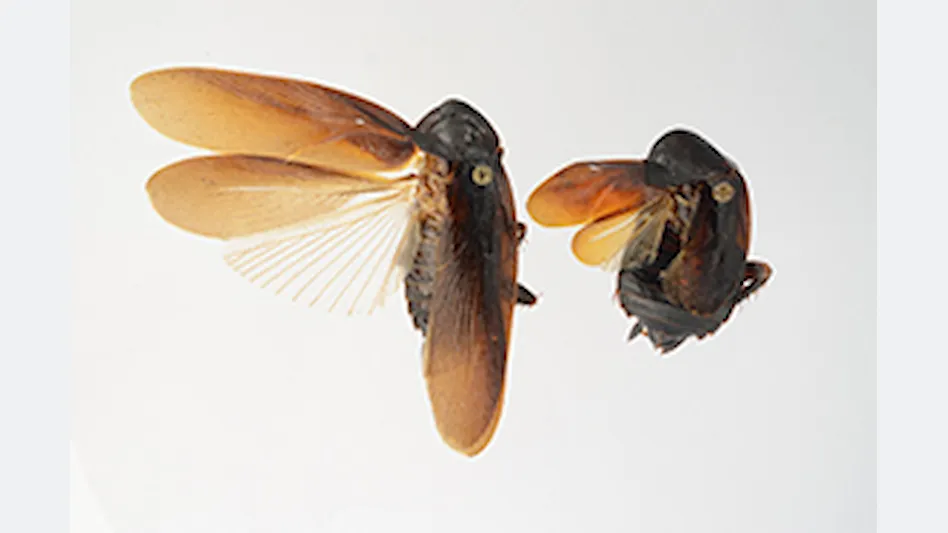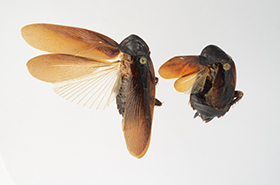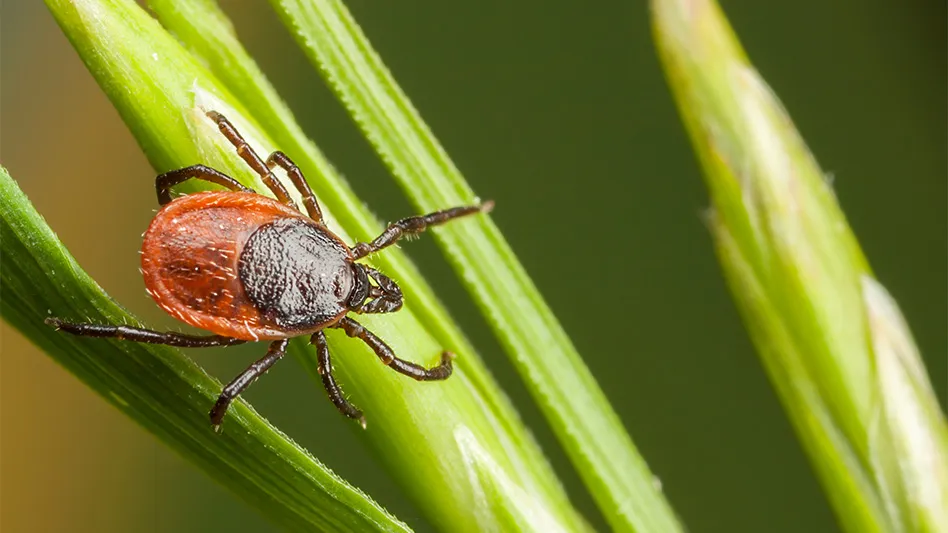
 Periplaneta japonica male and female (Photo: Lyle Buss, University of Florida Entomology) Periplaneta japonica male and female (Photo: Lyle Buss, University of Florida Entomology) |
The invasive cockroach, Periplaneta japonica, the Yamoto cockroach, has been confirmed in a Manhattan park. As its name implies, the cockroach is native to Japan, and this is the first time it’s been spotted in the United States.
Rutgers University insect biologists Jessica Ware and Dominic Evangelista said the species is well documented in Asia but was never confirmed in the United States until now. The scientists, whose findings were published in the Journal of Economic Entomology, say it is too soon to predict the impact but that there is probably little cause for concern. The new species will have to compete with the current species for space the food.
According to the Entomological Socieity of America, unlike the roaches that New York residents have known and hated for years, this variety can survive not just indoors where it’s warm, but also outdoors in freezing temperatures. The Asian species was first spotted in New York in 2012 by a pest management professional working at the park on Manhattan’s West Side. These cockroaches looked different to him, so he sent the carcasses to the University of Florida for analysis. The recipient, study co-author Lyle Buss, contacted the Smithsonian, which in turn brought in Ware because she had published several papers on cockroaches in the past. Evangelista, who is working toward a doctorate in Ware’s lab, performed barcoding, an analysis of the species’ genetic characteristics. That and other scientific methods he used confirmed what he and Ware suspected — the roach traps at the park had captured Periplaneta japonica.
| N.J. Company Makes Discovery The scientific community in the U.S. is abuzz with reports of the Yamato cockroach (Periplaneta japonica) — a species indigenous to Japan, China and southeast Russia — confirmed in New York City. The company that made the discovery — believed to be one of the first documented reports of this cockroach in the U.S. — is Bell Environmental Services, Fairfield, N.J.
Ken Schumann, entomologist and technical operations manager for Bell, told PCT this particular Yamato cockroach population was first observed by a Bell service professional in an elevated garden/walking park in New York City. The roaches were discovered by the technician during a routine inspection of rodent bait stations. “He had opened the station and observed the roaches eating the bait,” Schumann said. “He didn’t recognize the roach so he brought it back to me at the office. I thought it looked like an Oriental roach, but a little different.” After the roaches (both adults and nymphs) were examined by Schumann and two other entomologists, Schumann sent the samples to Dr. Austin Frishman, who consults for Arrow. Frishman then sent it to the University of Florida, then to the Smithsonian and it eventually ended up at Rutgers University, which used DNA barcoding to determine that the specimens was P. japonica. Schumann said that the New York P. japonica population appeared to seek refuge and shelter in and under manmade objects and also among the 100,000 ornamental plants. Large pockets of Yamato cockroaches were found under removable boardwalk sections in the garden’s walking paths as well as inside rodent bait stations and irrigation water valve boxes. Localized, targeted applications of a granular pyrethroid were conducted in July 2012 to specific segregated planting beds exhibiting activity and identified shelter zones. Specific numerical data were not collected on the effectiveness of the treatment, but anecdotal descriptions by park staff and follow-up inspections by the pest control company revealed that the single application was highly successful in suppressing the population and in some of the manmade shelter zones was 100% effective, Schumann said.* Schumann said Bell continues to monitor the roaches at this account and learn more about their biology and behavior. “What we’ve seen so far is that they are in pockets – isolated areas,” he said. “They seem to be an outdoor pest, like Pennsylvania wood roaches. I think we’ll know a lot more in the spring. We don’t have a lot of info on their biology and behavior in the U.S. — we’ll need to rely on information from Asia.” — Brad Harbison *Source: Periplaneta japonica – Yamato or Japanese cockroach, by Ken Schumann |
While it is too soon to predict the implications of its arrival, the Rutgers researchers say there probably is no reason for alarm. “Because this species is very similar to cockroach species that already exist in the urban environment, they likely will compete with each other for space and for food,” said Evangelista.
“Their combined numbers inside buildings could actually fall because more time and energy spent competing means less time and energy to devote to reproduction,” Ware added.
As for potential roach sightings on sidewalks and in parks during the dead of winter, Ware said encounters like that are possible. “I could imagine japonica being outside and walking around, though I don’t know how well it would do in dirty New York snow. The Asian researchers tested driven snow.”
There is also little likelihood that the different species could interbreed and create a hybrid super-roach because their genitalia don’t match. “Cockroach male and female genitalia fit together like a lock and key, and that differs by species,” Evangelista said. “So we assume that one won’t fit the other.”
Still, having a new six-legged neighbor could be unsettling. Ware has advice for New Yorkers who want to see fewer roaches, whatever the species. Some tips are obvious — sweep and vacuum so that food is not on the floor, and reduce clutter — while one suggestion may not be. Ware says using a dehumidifier could cut their numbers, because very dry air harms the cockroaches’ egg cases and reduces their ability to reproduce.
New Jerseyans, being right across the river, also have a more than casual interest in the new species. So far, Ware says, there have been no documented New Jersey sightings, but “they do very well as hitchhikers.”
Source: Entomological Society of America
Latest from Pest Control Technology
- Ground Control
- Scientists, PMPs Collaborating to Map Termite Distribution in Southern U.S.
- Viking Pest Control Organizes a Charity Bike Build for Local Families
- Gaining Control of Structure-Infesting Carpenter Ants
- Big Blue Bug’s Brian Goldman Receives Rhode Island Small Business Person of the Year Award
- UF Researchers Examine How Much Bait it Takes to Eliminate a Subterranean Termite Colony
- Women in Pest Control Group Continues to Grow, Provide Opportunities in the Industry
- NPMA Announces Results of 2024-2025 Board of Directors Election






